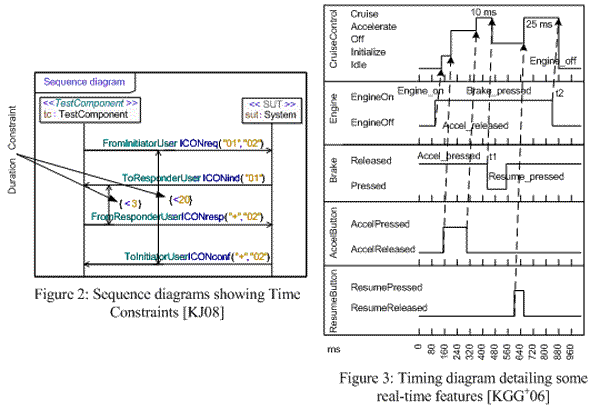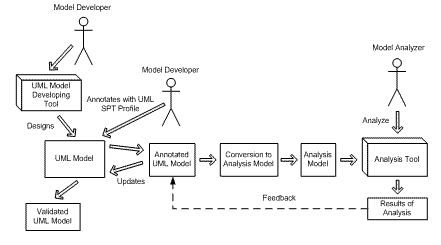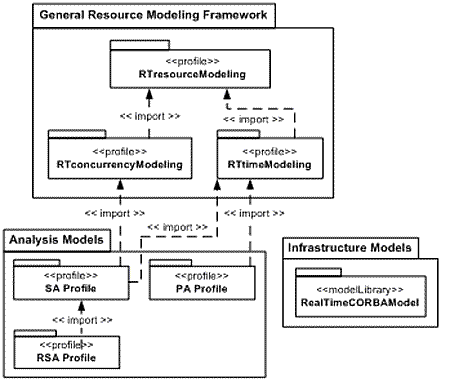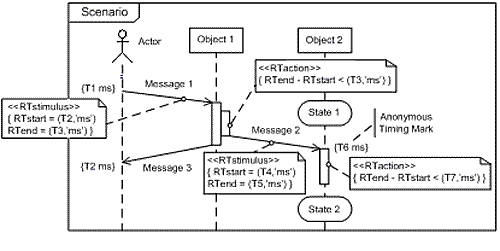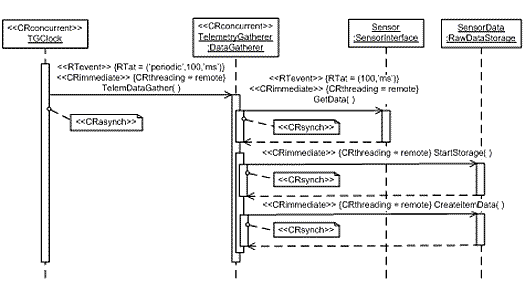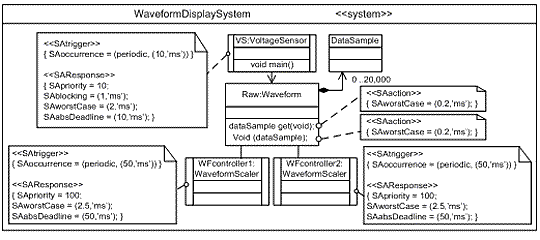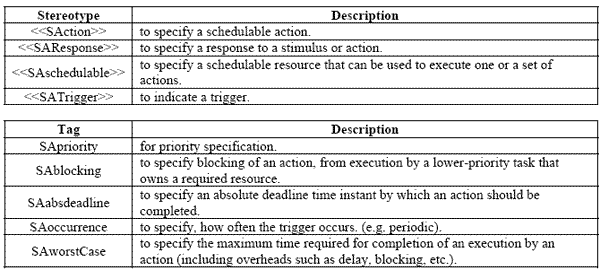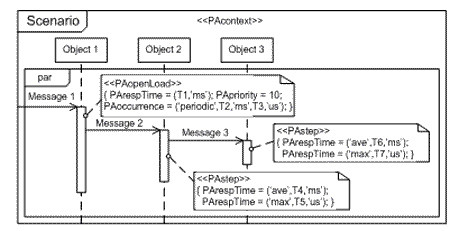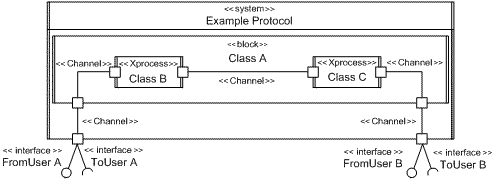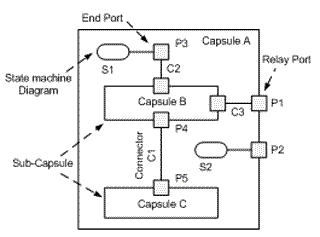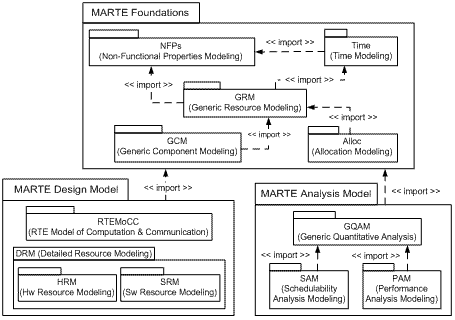AbstractValidation of non-functional and functional properties of these protocols during the early stages of design and development is important to reduce cost resulting from protocol anomalies, design errors like deadlock or livelock situations and/or violations of time constraints. The MDD approach promises a well-adapted formalism to bridge real-time protocol complexities and time to market pressure. UML with its several diagrams, supports techniques to overcome the aforementioned complexities. It also supports quantitative analysis through its real-time profiles. This paper reviews the most important real-time UML profiles which can be used for designing time-critical Industrial Communication Protocols (ICPs).
1 INTRODUCTIONCommunication systems as we know, serve as the backbone of any distributed system. They specify the chronology of the interaction between the communicating entities. Thus, when it comes to industrial applications, the design and development of ICPs of high reliability is very important because accurate exchange of protocol and application messages in a real-time environment is critical. However, development and design of such high quality industrial protocols for real-time environment is quite difficult and a complex task, as it demands developers with expertise in the field of ‘protocol engineering and system design’, implementation, validation, optimization and maintenance for developing such protocols. Further, protocols and systems have to be comprehensively designed and tested functionally before determining its performance. Errors in design result in redesign, which is costly and may lead to delays in delivery of the protocols or systems under development, which is not desirable. The advent of Unified Modeling Language version 2.0 (UML 2.0), promises to be a major breakthrough in the field of formal description techniques. The built-in extensibility mechanisms of UML 2.0 which facilitates extending UML 2.0 through profiles makes UML 2.0 an important candidate for modeling real-time protocols. Therefore, it is crucial to analyse the capabilities of various UML profiles in the context of modeling time-critical ICPs. Thus, in this paper we explore the capabilities of real-time UML profiles in expressing real-time, functional and non-functional properties of ICPs. The paper is not intended to provide a detailed description of these UML profiles, rather it focuses on showing how the main concepts of these profiles are useful in designing time-critical ICPs. This paper is organised as follows: section 2 deals with some of the built-in features of UML 2.0 for expressing real-time properties, section 3 is dedicated to UML profile for Schedulability, Performance and Time. The UML profile for Quality of Service (QoS) is explained in section 4. In section 5 we focus on UML CS profile dedicated for Communicating Systems. We review Rational UML profile UML-RT for designing real-time applications in section 6. The recently standarized OMG UML profile for Modeling and Analysis of Real-Time and Embedded Systems (MARTE) is discussed in section 7 and the paper ends with our conclusion in section 8. 2 REAL-TIME FEATURES AVAILABLE IN UML 2.0The UML 2.0 Specification [OMG05a] contains a rich set of concepts and modeling elements that supports modeling of some aspects of real-time systems. For example some functional characteristics of real-time systems like concurrency, timing constraints, etc. can be modeled using the inbuilt real-time features of UML 2.0. ConcurrencyConcurrency modeling in UML 2.0 is supported by active objects, concurrent operations and concurrent composite states. Further, ‘communication diagram’ provides message sequencing mechanism to model sequences of events, which is achieved by assigning a sequence number to each message. For e.g. let us consider the following set of messages [KGG†06]: 2a: [Enable=false]* In the above example, messages with sequence numbers 2a and 2b indicate that they can be simultaneously passed or triggered, provided that all messages with sequence number 1.x have been successfully triggered or passed already and the guard expression [Enable=false] is satisfied for triggering this message. The symbol ‘*’ shows that the following operation ‘Read’ is an iterative operation, which is performed every ms and ‘ While, Communication diagrams use message sequencing mechanism to model concurrency, Sequence diagrams use the concept of Combined Fragment to indicate parallel execution of set of operations. Combined Fragment, containing the interaction operator ‘par’ as shown in figure 1 can be used to express concurrent operation. Figure 1 shows an interaction with one server and two users. Each user makes a request; the server performs the service and replies to the user. In this example, there is no specified ordering among the two interaction sequences which, indicates that the request event of the two users may occur concurrently.
Figure 1: Parallel combined fragment in sequence diagram [RJB06] Timing constraints
In addition to concurrency the other important characteristic of real-time ICPs are the ‘Timing constraints’. In order to express timing constraints UML 2.0 provides Time Event concept with the help of two data types namely Time and Time Expression [GK06], [OMG05a] which specifies an absolute or relative (relative to the occurrence of other events) point in time when the event occurs using expressions. These times related constraints can be used either in state diagrams or in sequence diagrams (the latter is shown in figure 2). The ‘Time constraints’ can be in the form of duration, as well as certain instants of time; sequence diagram supports both. In timing diagrams, time is expressed on the linear axis while the message/event interaction among the different lifelines/objects and their effects can be expressed using different states for the lifelines. Figure 3 presents an example of a timing diagram of a Cruise Control system studied in [KGG+06] showing the possible system behavior with time when message/events are passed among different lifelines of the cruise control system. This figure shows, on receiving the brake_pressed and engine_off signals, the cruise control system should satisfy the real-time constraints of 10 ms and 25 ms respectively. According to a scientific work [KGG+06], the most visible way of expressing time related constraints is provided by Timing diagrams. However, when it comes to modeling real-time constraints, which involves event handling among many lifelines, Sequence diagrams score over Timing diagrams. UML 2.0’s extension mechanismApart from the above mentioned inbuilt features of UML 2.0 for modeling real-time ICPs, the most important feature is UML 2.0’s built-in extensibility mechanisms; which facilitates extending UML 2.0 through profiles which support real-time modeling. These profiles are discussed in the following sections. 3 UML PROFILE FOR SCHEDULABILITY, PERFORMANCE AND TIMEUML profile for schedulability, Performance and Time (UML/SPT) [OMG05b] is an OMG standard UML profile suitable for modeling and analysis of real-time systems. It is a framework to model resource, time and concurrency concepts, and to support predictive quantitative analysis of UML models by supporting schedulability and performance analysis. The profile does not invent any new techniques, but rather codifies the art of capturing timeliness and related properties. The profile provides stereotypes, tagged values and constraints with specific names that can be used to annotate UML diagrams with quantitative details. The primary benefit of annotating UML models with these information, is the ability to exchange quantitative properties between different tools, such as UML modeling tools and analysis tools for schedulability and performance analysis. Figure 4 shows the expected Paradigm for the SPT Profile. Here in this figure, the Model developer designs the UML model using a UML modeling tool. Once the UML model is designed, the developer annotates the model with quantitative information. Then the annotated UML model is converted into an analysis model appropriate for analysis by the Analysis tool. Upon completion of the analysis, the analysis tool updates the user model which can then be validated.
Figure 4: Usage Paradigm for the SPT Profile, based on [Woo07]
Figure 5: Organizational structure of SPT profile [OMG05b] The UML SPT profile is divided into 3 sub-profiles for better understandability and usage. The organizational structure of the profile with its three primary packages namely a) General Resource Modeling Framework, b) Analysis Model c) Infrastructure is shown in figure 5. General Resource Modeling FrameworkThis package contains the basic concepts of real-time systems. It is further subdivided into 3 more sub-packages or sub-profiles:
Figure 6: UML Model Annotated with RT Time Modeling sub-profile, based on [Dou06]
Table 1: Commonly used Stereotypes and Tag values of RT Time Modeling
Figure 7: UML Sequence diagram annotated with RT Concurrency Modeling sub-profile [OMG05b]
Table 2: Commonly used Stereotypes and Tag values of RT Concurrency Modeling Analysis Modeling Package
Figure 8: UML Model annotated with ‘SA Profile’ stereotypes, based on [Dou06] This package provides sub-packages for different kinds of analysis. It is subdivided into 2 sub-packages or sub-profiles:
Table 3: Commonly used Stereotypes and Tag values of SA Profile
Figure 9: UML diagram annotated Performance Analysis Sub-profile (PA profile), based on [Dou06]
Table 4: Commonly used Stereotypes and Tag values of PA Profile Real-Time CORBA (Common Request Broker Architecture) Sub-profile (Infrastructure Modeling) The main objective behind introducing this sub-profile in UML SPT profile is to provide an extension to facilitate schedulability analysis of Real-Time CORBA applications. It is a middleware standard owned by OMG. Since this sub-profile falls beyond the scope of our research work, we are not discussing this sub-profile in detail. Interested readers can refer to [OMG05b] for more information. UML SPT profile is too vast to be completely covered by this paper. Hence, to have an exhaustive understanding of this profile, interested readers can refer to [GK06], [OMG05b], [Woo07] and [Dou06]. 4 UML PROVILE FOR QUALITY OF SERVICE (QoS)The QoS profile was adopted by OMG in June 2004 [OMG08]. The QoS profile provides the user with facilities to define a wider variety of QoS requirements and properties as compared to SPT profile, which focuses mainly on schedulability and performance analysis [BP04]. The SPT profile was the first attempt to extend UML with real-time properties like timing and concurrency concepts, for expressing requirements and properties needed for performing schedulability and performance analysis. The QoS profile on the other hand was introduced to complement UML/SPT profile. It broadens the scope of specifying real-time properties by allowing the users to define open variety of quality of service requirements and properties [BP04]. UML/QoS allows model developers to define any set of quality of service requirements and perform specific analysis like performance, schedulability and even dependability [Mig03]. Proposed annotation procedure of QoS profileThe annotation procedure proposed by the Quality of Service (QoS) profile consists of the following three steps:
SPT profile Vs QoS profile
4 UML PROFILE FOR COMMUNITCATING SYSTEMSUML 2.0 is a collection of several semi-formal standard notations and concepts for modeling software systems at different stages and views of the same system. The lack of strong formality in non-profiled UML is beneficial at the early stages of development. In later stages of simulation, validation and implementation, UML is too imprecise to fulfill this task for which SDL is well suited. While UML 2.0 features multiple viewpoints, informal object models and property model views, SDL offers detailed formalized object models with respect to execution semantics. However, in practice, UML is made more formal by binding semantic variations in the UML language and providing a more precise behavior either in the form of a tool or as a language profile [WKH06]. As per [WKH06], the goal of “UML profile for Communicating Systems” (UML CS) [Wer06] is to bridge the gap between the requirement, analysis and design phase by combining the strengths of UML and SDL. The UML CS profile by means of stereotypes, tagged values and constraints has extended the elements of composite structure diagrams, class diagrams and state machines in such a way that their usage becomes more obvious and aligned to SDL. Apart from providing a mapping to SDL, the profile provides additional set of high-level modeling concepts and language elements, which are not currently supported by SDL, but are necessary for modeling and engineering current and upcoming communication protocols. From Industrial Communication Protocols’ point of view, they can be used in ‘Virtual Automation Networks’ (VAN) [VAN08]. Concept of the UML CS profile
Figure 10: Composite Structure diagram of an Exmple Protocol Using UML CS Profile The structural modeling elements of UML CS profile are similar to SDL, i.e. it supports system, block, process and package agents. Decomposition of system design is supported by nesting agents within other agents. A system’s structure can be specified using classes and composite structures. Classes can be used to define the types of agents (system, block or process) which can then be instantiated with a composite structure. Further, operations, attributes, signals and timers with their scopes can also be defined. The composite structure instantiates the agents along with their multiplicities and specifies the communication paths by means of connectors or channels. It also specifies interfaces for signals and remote procedure calls (figure 10 shows an example of usage of UML CS profile). Agents modeled by active classes which execute a behavior after initiations are called ‘Processes’. State machines are used for describing the behavior of processes. The only exception is, only activities can be used to define data type operators. This is because an activity in UML CS must not wait for triggers. Further, an additional set of stereotypes provided by UML CS profile supports specifying ASN.1 based data types. However, only a subset of the ASN.1 notations is supported. To have an exhaustive understanding of the UML CS profile, interested readers can refer to [WKH06], [Wer06] and [Woc06]. Major extensions to UML 2.0 for Real-time Communication Protocols
6 UML PROFILE FOR REAL-TIME SYSTEMS (UML RT)
UML-RT is an industrial standard [AT05], which primarily focuses on architecture specification of real-time systems/protocols. Further, the behavior of the system can be modeled using UML state machine diagrams. UML-RT has introduced four new building blocks (namely capsules, ports, connectors and protocols) to the standard UML meta-model for modeling the structure and the behavior of complex real-time systems. Structural ModelingThe three new structural constructs introduced by UML-RT for structural modeling are capsules, ports and connectors:
Figure 11: Component Architecture of UML RT Figure 11 shows UML-RT component architecture that includes the aforementioned concepts, where Capsule A is made up of sub-capsules Capsule B and C. Port P1 (relay port) of Capsule A is connected to a sub-capsule Capsule B, which owns an internal port P3 (end port). Port P3 connects the port of sub-capsule Capsule B, with a state machine diagram. Similarly, Port P2 (end port) of Capsule A is connected to a state machine diagram which specifies the behavior of Capsule A. Connectors are used for modeling communication channels between two or more ports. Ports P3 and P5 realize complementary roles of their mutual protocol and are connected with the help of a Connector C1. The systems behavior at the architectural level is defined by its ‘Protocols’ and ‘Connectors’. Behavioral ModelingState machines specify the functional behavior of the components. Capsules without state machines are only containers for sub-capsules. Compared to UML state machines, UML-RT state machines do not allow concurrent states. Signals arriving at end ports are handled by state machines. ‘Protocol’ is a new construct introduced by UML-RT with respect to behavior modeling. Protocols specify a desired behavior that can occur over a connector. Even though, UML-RT provides constructs to model complex real-time industrial protocols, the major pitfall of UML-RT is, its modeling entities and syntactic constructions lack precise semantics and clearly defined syntax. Further, UML-RT does not support modeling timing issues. However, when it comes to scheduling, the profile introduces a set of common scheduling annotations (including absolute and relative deadlines, worst-case completion time and priority) which are fairly sufficient to perform basic schedulability analysis. To have a detailed understanding of UML RT, interested readers can refer [SR98], [Sel98], [SGM+92], [AT05] and [Sel05]. 7 UML MARTE PROFILEThe recently standardized UML Profile for Modeling and Analysis of Real-Time and Embedded systems (UML MARTE Profile) [OMG07] introduces domain specific ideas relevant for modeling real-time and embedded systems design involving the ability to express non-functional properties, execution platforms, resource allocation, quantifiable notions of time, etc. available within the unified modeling framework. These features of UML MARTE, from our project’s point of view are very important because modeling of ICPs involve a great deal of the above mentioned non-functional runtime properties.
Figure 12: Organizational Structure of MARTE Profile, based on [DTA+08] The MARTE profile is intended to replace the existing UML Profile for Schedulability, Performance and Time (SPT) [OMG05b]. The architecture of MARTE profile consists of three main packages namely MARTE Foundation package, MARTE Design Model and MARTE Analysis Model as shown in figure 12. MARTE Foundation packageThis package defines all the basic foundational concepts required for design and analysis of real-time and embedded system. It provides model developers with constructs for modeling the following:
The concepts defined using this foundation package are then refined in the following two packages to support modeling and analysis concerns of the real-time system. MARTE Design ModelThis package addresses model-based design starting from requirement capture to specification, design and implementation. It provides high level concepts for modeling both, quantitative and qualitative features of real-time systems/protocols. Further, it also provides means for detailed description of software and hardware resources used for execution of an application.
Once the Hardware Resource Modeling and Software Resource Modeling are completed, they are combined to support the whole application execution. MARTE Analysis Model:This package offers specific abstractions and relevant annotations that could be read by analysis tools. MARTE analysis is intended to provide trustworthy and accurate evaluations using formal quantitative analysis based on sound mathematical models [OMG07]. This package is sub-divided into three other packages, namely:
For a very detailed understanding of UML profile for MARTE, readers are requested to refer [OMG07], [DTA+08], [FBS+07], and [HH08]. 8 CONCLUSIONThe complexity of real-time Industrial Communication Protocols demand usage of adequate modeling language. In our previous research work [KJ08], we were able to show that UML 2.0 can be applied to all phases of industrial communication protocol engineering aided with automated testing facility. However, in [KJ08] we concentrated more on functional properties, but non-functional real-time properties are as important as functional properties. Hence, this work reviews the various real-time UML 2.0 profiles which can be used for engineering non-functional real-time properties of ICPs. Based on our review, we can say that UML SPT profile has initiated many research works in the context of addressing non-functional properties. Nevertheless, UML SPT does have a considerable amount of limitations as discussed in [Ger04], [OMG] and [WP04]. The UML QoS profile, which was introduced to complement UML SPT profile, is more flexible as it allows users to customize the QoS characteristics but lags when it comes to supporting symbolic variables and expressions. In [BP04], it is explained, that both SPT and QoS profiles struggle to cope with the balance between flexibility and simplicity/convenience of expression. The UML MARTE profile, which succeeds the UML SPT profile uses model based approach together with quantitative analysis approach (SAM and PAM sub-profiles). This allows model designers to annotate additional information needed for various analysis to be attached directly on to the actual design model, rather than creating dedicated models for analysis. Thus, we have planned to investigate the potential of these features of UML profile for MARTE for engineering non-functional real-time properties of Industrial Communication Protocols. REFERENCES[AMS07] C. André, F. Mallet and R. de Simone: "Time Modeling in MARTE", in proceeding of Forum on specification & Design Languages (FDL ’07), Barcelona, Spain, September 2007. [AT05] K. B. Akhlaki and M. I. C. Tunon: “Combining the Description Features of UML-RT and CSP+T Specifications Applied to a Complete Design of Real-Time Systems”, in proceeding of World Academy of Science, Engineering and Technology, vol. 7, Prague, Czech Republic, 26 -28 August, 2005. [BMP+07] P. Boulet, P. Marquet, E. Piel, and J. Taillard: “Repetitive Allocation Modeling with MARTE,”in proceeding of Forum on specification and design languages (FDL’07), invited paper, Barcelona, Spain, September 2007. [BP04] S. Bernardi and D. C. Petriu: “Comparing two UML Profiles for Non-functional Requirement Annotations: the SPT and QoS Profiles” in proceeding of Second International Workshop on Specification and Validation of UML Models for Real Time and Embedded Systems (SVERTS), Lisbon, Portugal, 11 October 2004. [Dou06] B. P. Douglass: Real Time UML Third Edition, Addison Wesley, Feb 2006. [DTA+08] S. Demathieu, F. Thomas, C. André, S. Gérard and F. Terrier: “First Experiments Using the UML Profile for MARTE”, in proceeding of 11th IEEE Symposium on Object Oriented Real-Time Distributed Computing (ISORC 2008), pp. 50-57, USA, 5-7 May 2008. [FBS+07] M. Faugère, T. Bourbeau, R. de Simone and S. Gérard: “MARTE: Also an UML Profile for Modeling AADL Applications”, in proceeding of 12th IEEE International Conference on Engineering Complex Computer Systems (ICECCS 2007), pp. 359-364, Auckland, New Zealand, 11-14 July, 2007. [Ger04] S. Gerard: “Report on SIVOES 2004 – SPT”, in proceeding of Workshop on the usage of the UML profile for Scheduling, Performance and Time, Toronto, Canada, 2004. [GK06] Abdelouahed Gherbi and Ferhat Khendek:“UML Profiles for Real-Time Systems and their Application”, in Journal of Object Technology, vol.5, no.4, May-June 2006, pages 149-169, http://www.jot.fm/issues/issue_2006_05/article5 [HH08] M. Hagner and M. Huhn: “Tool Support for a Scheduling Analysis View”, in proceeding of Design, Automation and Test in Europe (DATE’08), Munich, Germany, 10-14 March 2008. [KGG†06] M. U. Khan, K. Geihs, F. Gutbrodt, P. Gohner and R. Trauter: “Model-Driven Development of Real-Time Systems with UML 2.0 and C”, in proceedings of the 4th Workshop on Model-Based Development of Computer-Based Systems and 3rd International Workshop on Model-Based Methodologies for Pervasive and Embedded Software, March 2006. [KJ08] Barath Kumar and Jürgen Jasperneite : “Industrial Communication Protocol Engineering using UML 2.0: a Case Study”, in 7th IEEE International Workshop on Factory Communication Systems (WFCS 2008), Dresden, Germany, May 2008. [OMG] OMG: “Pending Issues sent to the OMG Finalization Task Force: UML Schedulability, Performance and Time Profile”, http://www.omg.org/issues/uml-scheduling-ftf.open.html. [OMG05a] OMG: “Unified Modeling Language: Superstructure”, Version 2.0, formal/05-07-04, August 2005. [OMG05b] OMG: “UML Profile for Schedulability, Performance, and Time Specification”, OMG Adopted Specification, Version 1.1, formal/05-01-02, January 2005. [OMG07] OMG: “A UML Profile for MARTE”, OMG Adopted Specification, Version Beta 1, OMG Document Number: ptc/07-08-04, August 2007. [OMG08] OMG: “UML Profile for Modeling Quality of Service and Fault Tolerance Characteristics and Mechanisms”, Version 1.1, formal/2008-04-05, April 2008. J. Rumbaugh, I. Jacobson and G. Booch: The Unified Modeling Language Reference Manual, Second Edition, Addison Wesley, February 2006. [Sel98] B. Selic: Using UML for modeling complex real-time systems, Lecture Notes in Computer Science 1474, Springer-Verlag, pp. 250-260, 1998. [Sel01] B. Selic: “A UML Profile for Modeling Complex Real-Time Architectures”, Rational Software Inc., 2001. [SGM+92] B. Selic, G. Gullekson, J. McGee and I. Engelberg: “ROOM: An object-oriented methodology for developing real-time systems”, in proceeding of 5th International Workshop on Computer-Aided Software Engineering, pp. 230-240, July 1992. [SR98] B.Selic and J.Rumbaugh: UML for modeling complex real-time systems, Technical report, Object Time, 1998. [VAN08] VAN: “Investigation for future communication”, Available at: http://www.van-eu.eu/ , July 2008. [Wer06] C. Werner: A UML Profile for Communicating Systems, PhD thesis, Georg-August-Universitat, Gottingen, Germany, 2006. [WKH06] C. Werner, S. Kraatz and D. Hogrefe: “A UML Profile for Communicating Systems”, in proceeding of the Fifth Workshop on System Analysis and Modelling (SAM 06), pp 81-90, Kaiserlautern, Germany, June 2006. [Woc06] J. Woch: A UML Profile for Communicating Systems – Informal semantic Comparison and Example, Master thesis, Georg-August-Universitat, Gottingen, Germany, November 2006. [Woo07] M. Woodside: “From Annotated Software Designs (UML SPT/MARTE) to Model Formalisms”, in 7th International School on Formal Methods for the Design of Computer, Communication, and Software Systems, SFM 2007, Bertinoro, Italy, May 28-June 2, 2007. [WP04] M. Woodside and D. Petriu: “Capabilities of the UML Profile for Schedulability Performance and Time (SPT)”, in proceeding of Workshop on the usage of the UML Profile for Scheduling, Performance and Time (SIVOES-SPT), Toronto, Canada, June 2004.About the authors
Barath Kumar and Juergen Jasperneite: “UML Profiles for Modeling Real-Time Communication Protocols”, in Journal of Object Technology, vol. 9, no. 2, March-April 2010, pp. 178-198 http://www.jot.fm/issues/issue_2010_01/article1/ |
||||||||||

